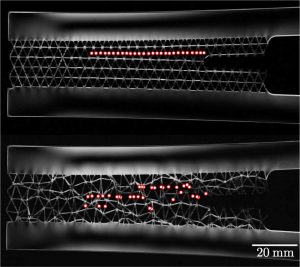
In contrast to the structured design (top), the more disordered one (bottom) cracked less easily, as evidenced by the dispersion of fracture events (red dots). (Credit: Sage Fulco)
Kevin T. Turner and Doug Durian, University of Pennsylvania & Michal Budzik, Aarhus University
Outcome: Researchers have demonstrated that introducing geometric disorder in mechanical metamaterials leads to distributed damage during failure, resulting in significantly enhanced fracture toughness with minimal loss of strength. This finding challenges the traditional reliance on periodic unit cell geometries in architected materials.
Impact and Benefits: This research provides a new approach to designing mechanical metamaterials with enhanced fracture toughness. The study opens possibilities for creating materials that are more damage-tolerant by leveraging disorder. These materials have various applications, including structural materials for aerospace and vehicles, protective gear, and biomedical devices.
Explanation: Geometric disorder was introduced into regular triangular lattices by perturbing nodal locations, and the impact on damage distribution and toughness was investigated. Improvements in toughness with increasing disorder, up to a limit, were observed in computational simulations and mechancis experiments. A mechanics-based scaling law that relates toughness to local changes in strength and the number of fracture events was shown to predict the changes in toughness with disorder.
Fulco, S., Budzik, M. K., Xiao, H., Durian, D. J., & Turner, K. T. (2025). Disorder enhances the fracture toughness of 2D mechanical metamaterials. PNAS nexus, 4(2), pgaf023. https://doi.org/10.1093/pnasnexus/pgaf023
